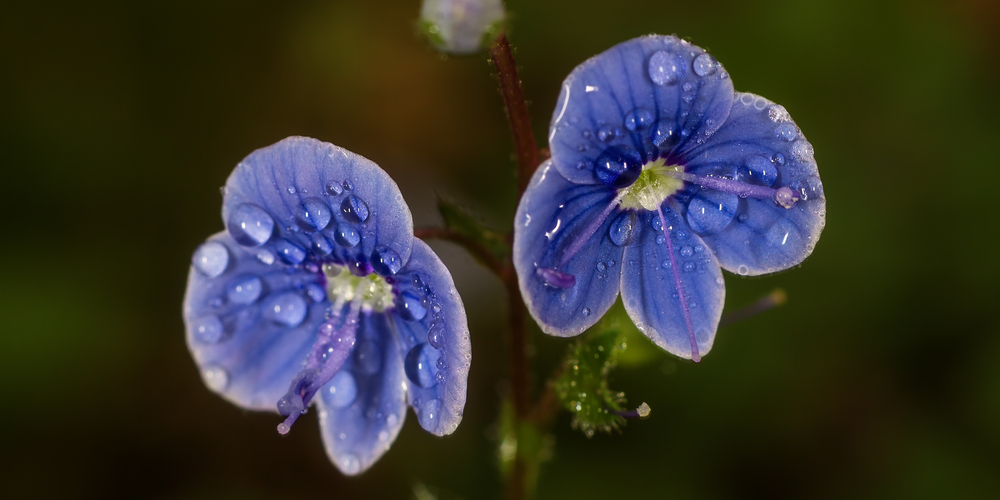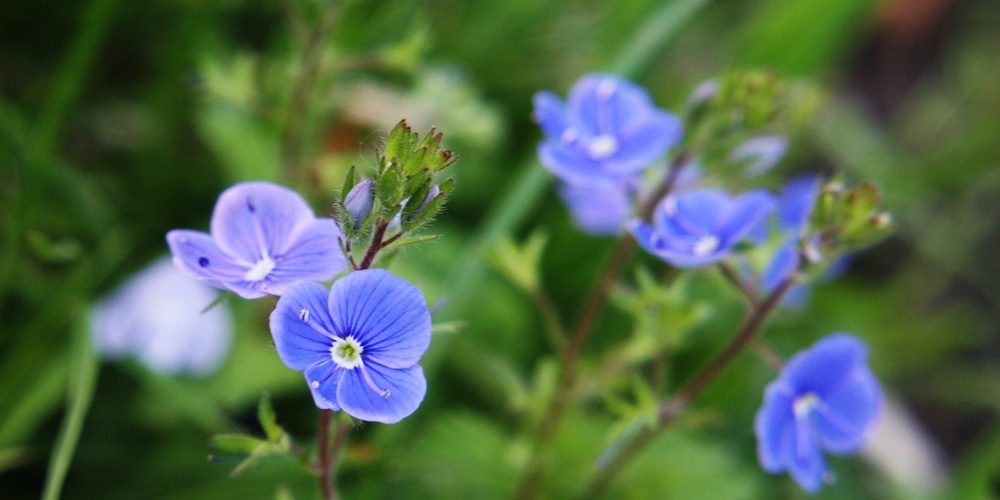One of the joys of early spring is spotting the first signs of life emerging from the cold, barren earth. Grasses start to green, trees begin to bud, and flowers start to bloom. For many people, these first signs of spring are heralded by the appearance of daffodils and tulips. But along with these more showy spring flowers, you may have also noticed little blue flowers in your grass.
While these blue flowers may be pretty, are they supposed to be there? Or should you be concerned about their appearance? Let’s find out!
Little Blue Flowers in Grass: What Are They?
There are a few different types of flowers that could be responsible for the blue blooms on your lawn. Among these, Corn Speedwell (Veronica arvensis) is the most likely culprit.
Corn Speedwell is an annual weed that reproduces by seed. So if you have them on your lawn, it’s likely because their seeds were brought in on your shoes or clothing or perhaps in a load of mulch or topsoil.
Aside from appearing on your lawn, you may also see them in public parks, gardens, and natural areas. They’re most commonly found in sunny areas but can also tolerate some shade.
Characterized by their small size (about ½ inch in diameter), these pretty blue flowers have four petals arranged in a cross-shape. They’re most commonly seen blooming from mid-spring to early summer. Its leaves are bright green, oval-shaped, and have a toothed margin.
While they may be pretty, corn speedwells are considered weeds because they crowd out desirable grasses, stealing vital nutrients and water in the process. Like most weeds, once they’ve started to take over, they can be very difficult to get rid of.
What Can You Do About Corn Speedwell Flowers on Your Lawn?
If you have a few corn speedwells blooming here and there, you may not need to do anything about them, at least yet.
Although annuals, corn speedwells can be very difficult to control because they produce so many seeds – a single plant can create up to 250,000 seeds in one season!
Mechanical Removal
One of the simplest ways to get rid of corn speedwells is to pull them up by hand. Whether they’ve taken up residence on your lawn or in a flower bed, manually removing them is often the best way to go.
This is easier if you only have a few plants and if the ground is moist. Simply grab the plant close to the base and pull it up. This will also help to reduce the chances of leaving behind any roots or stem pieces that could re-sprout.
Alternatively, if they’ve spread throughout your turf, you can use a lawn rake to remove them. A clam rake or thatching rake will work best for this. Run the tines of the rake through the grass, and it will pull up the corn speedwells along with their roots.
Chemical Removal
If you have a large infestation or if manual removal is too much work, you can try using a herbicide. Remember, however, that herbicides will also kill your grass, so you’ll need to be careful when applying them.
A selective herbicide with the active ingredient triclopyr is the best option for getting rid of corn speedwells without harming your lawn. It is a selective post-emergent herbicide, meaning it will only kill plants that it comes in contact with – not the grass.
You may apply this as soon as the corn speedwells appear on your lawn. Be sure to follow the directions on the label, and use it on a calm day, with little to no chance of raining. This is to prevent the herbicide from being washed away before it has a chance to work.
You may need to reapply the herbicide every few weeks until the corn speedwells are gone for good. Treating your lawn for corn speedwells is an annual task, but by taking care of them early, you can help prevent them from getting out of control and taking over your lawn!
Early Prevention
Like most types of weeds, Corn Speedwell may not pose a significant risk if caught early. And if you have a healthy lawn, it’s better equipped to handle a few weeds here and there. This means constantly feeding your grass with fertilizer during the spring or summer helps prevent the spread of Corn Speedwells or most weeds, for that matter.
Another early prevention method is to keep your lawn mowed at the correct height. For most grasses, this is around two to three inches. A taller lawn will help shade out the weed seeds, preventing them from germinating. Most homeowners think cutting their grass too short will help prevent weeds, but this actually has the opposite effect.
A shorter lawn is more susceptible to drought and disease, which gives weeds a chance to take over. Be sure to use a sharp mower blade too – a dull one will tear your grass, making it even more vulnerable to weeds.
Little Blue Flowers in Grass: Final Thoughts
Weeds and grass almost seem like they go hand in hand, but the secret lies in early prevention and treatment. By keeping your lawn healthy, well-fertilized, and mowed, you can help prevent weeds from taking over.
Related Article: Speedwell Weed Taking Over Your Lawn

